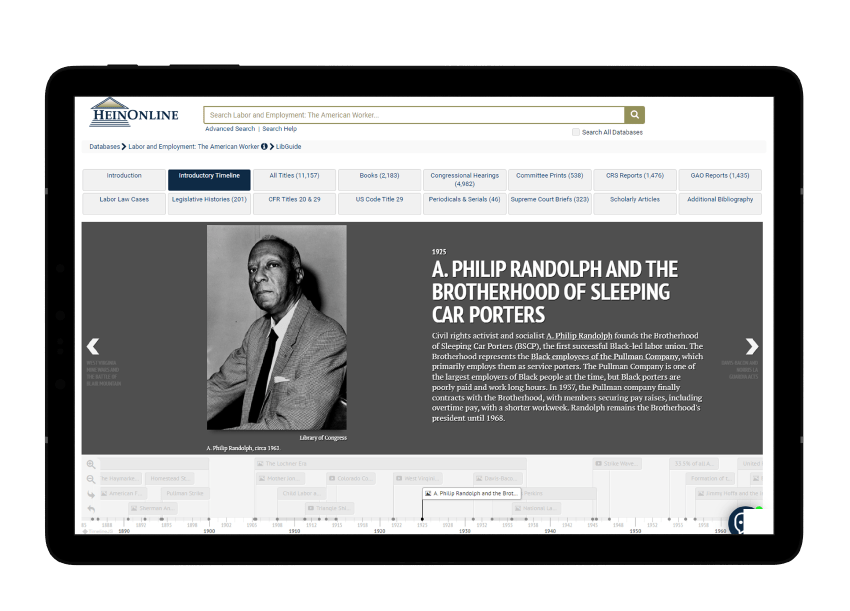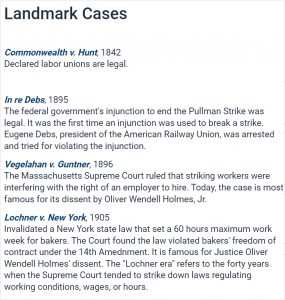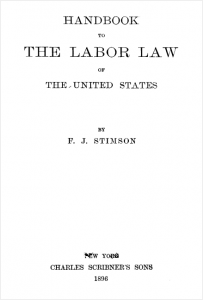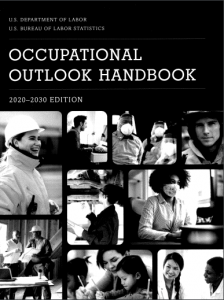NEW DATABASE!

Labor & Employment: The American Worker
Explore the plight and successes of America’s working class with HeinOnline’s editorialized collection of more than 10,000 titles that illuminate the history of labor conditions and employment law in the United States.
11,476
TITLES
15,119
VOLUMES
5,365,847
PAGES
10,984
TITLES
14,659
VOLUMES
5,244,894
PAGES
About the Labor and Employment Database
Includes an interactive timeline
FULLY EDITORIALIZED
10,000+ SUBJECT-CODED TITLES
CONTENT ADDED REGULARLY
- Fully Editorialized
- 10,000+ Titles
- Content Added Regularly
Immerse yourself in the rich history and current landscape of America’s workforce with HeinOnline’s Labor and Employment: The American Worker. This comprehensive database combines legislative histories, Supreme Court case briefs, accounts of historical labor riots, current reports on working conditions, and so much more.
Get a unique perspective with our chart of landmark court cases related to labor and employment law, including links to the full text, synopsis, and explanations of each case’s significance in both labor jurisprudence and history. From state court cases that impacted the entire country, to decisions made in the U.S. Supreme Court, this database covers cases from 1842 to 2018.
In addition to over 10,000 subject-coded titles, our editors have carefully curated hundreds of expertly written scholarly articles on topics like employment protections, labor contracts, collective bargaining, and more, all ranging from 1904 to present and with new articles added each month.
For those looking to further their research, our editors have even selected over 200 highly recommended titles. While full text of these titles is not available in the database, each title is linked to its WorldCat entry to help users locate the book in a nearby library.
Title List: KBART (TXT) | CSV | HTML
Understanding the Labor Landscape in America
In 1866, National Labor Union, the first national labor group in the United States, was founded. One of their first actions was a national call for an 8-hour workday at a time when a 10 or 12-hour workday, six days a week, was standard.
Into the 20th century, workers and employers frequently came to blows, bullets, and bombs over better pay and safer working conditions. Some of the most infamous incidents include the Great Railroad Strike of 1877, the Haymarket Riot in 1886, the Homestead Massacre in 1892, and the Battle of Blair Mountain in 1921. These strikes, like many others, were all unsuccessful. The early part of the 20th century brought the passage of many of the federal laws that molded today’s legal landscape for workers, such as the Norris-La Guardia Act, and the National Labor Relations Act, and the Taft-Hartley Act. Union membership peaked in 1954.
While workers have made tremendous gains in workplace regulations, protections, rights, and equality, the modern workplace is far from perfect. In 2021, the Bureau of Labor Statistics estimated that women earned 83% as much as men. In the wake of the Covid-19 pandemic, workers resigned from their jobs en masse, citing poor wages, lack of benefits, and a high degree of job dissatisfaction. Meanwhile, the federal minimum wage in the United States, at $7.25 per hour, has gone unchanged since 2009.
Using the Timeline
This database features an interactive timeline that charts labor efforts to organize from 1842 up to the current decline—and rise—of unions in America. Interspersed within the timeline are acts, court cases, statistics, and more, represented through images, videos, and links to full-text documents in HeinOnline.
Hyperlinks
Hyperlinks take users to the quoted documents where they reside in HeinOnline, or to supplemental resources.

Photographs
Photos put faces to the names of people mentioned on a given timeline point. Source information and captions are included.
Linear Calendar
The linear calendar plots all the timeline points by month and year. It can also be used to jump to different events.
Featured Content
Content will continue to be added regularly!
Unique to this database is a chart of landmark court cases related to labor and employment law.
- Shows 24 landmark court cases, accompanied by their decision year and a brief synopsis of the case
- Each case is linked directly to the original full-text decision
- Includes cases from the U.S. Supreme Court and state courts
- Cases included range from 1842 to 2018

Browse thousands of books ranging in date from the early 1900s to present day. Find accounts of the Haymarket Riot and other famous labor uprisings, treatises decrying communism, histories of unions, and more.
Some titles you may want to check out include:
- Jean Trepp McKelvey. AFL Attitudes toward Production, 1900-1932 (1952)
- History of Organized Felony and Folly: The Record of Union Labor in Crime and Economics (1923)
- F. J. Stimson. Handbook to the Labor Law of the United States (1896)
- William B. Johnston; et al. Workforce 2000: Work and Workers for the Twenty-First Century (1987)

Committee Prints and Congressional Hearings
HeinOnline editors have hand-selected committee prints and congressional hearings that provide insight into the federal government’s stances on the state of labor and employment. Noteworthy publications include:
- Jurisdictional Standards of the National Labor Relations Board: A Report (1957)
- Balancing Work, Health, and Family: The Case for Expanding the Family and Medical Leave Act (2020)
- Immigration : economic impact on American workers and their wages (2006)
Congressional Research Service & Government Accountability Office Reports
Additionally, we have pulled nearly 3,000 relevant reports from the Congressional Research Service (CRS) and Government Accountability Office (GAO), such as:
- Child Labor in America: History, Policy, & Legislative Issues (2013)
- Mine Safety: Labor’s Progress In Doing Required Inspections (1986)
- Real Wage Trends, 1979 to 2019 (2020)
Legislative Histories
Additionally, this collection includes nearly 200 legislative histories that illustrate the progression of essential labor-related laws, including:
- Fair Labor Standards Act 1938
- Legislative History of the Equal Employment Opportunity Act of 1972, P.L. 92-261
- Railway Labor Act of 1926: A Legislative History
Code of Federal Regulations
The Code of Federal Regulations (CFR) represents the current statutory positions of the federal government. Our editors have selected sections of the CFR that are relevant to the American workforce, such as:
- CFR Title 20: Employees’ Benefits
- CFR Title 29: Labor
- US Code Title 29: Labor
Supreme Court Briefs
Users will find more than 300 Supreme Court briefs that follow the Court’s judgments on various employment-related issues. These briefs contain the arguments and positions of parties in the cases.
Some of the briefs in this database include:
- Alfred J. Gobeille, in His Official Capacity as Chair of the Vermont Green Mountain Care Board, Petitioner, v. Liberty Mutual Insurance Company, Respondent. Petition for a Writ of Certiorari (2014)
- Cedar Point Nursery and Fowler Packing Co., v. Victoria Hassid. Brief Amicus Curiae of American Federation of Labor and Congress of Industrial Organizations (2021)
- Gerald Lynn Bostock, v. Clayton Country, Georgia. Brief for Business Organizations as Amici Curiae in Support of the Employees (2019)
Scholarly Articles
Access hundreds of articles* selected by HeinOnline editors on employment discrimination, wrongful termination, collective bargaining, how the New Deal shaped labor law, right-to-work laws, labor disputes in major league sports, and more. Sort articles by Title, Author, Most-Cited, or Year, or search the list by Title or Author.
*In order to access the scholarly article links, you must be subscribed to the appropriate HeinOnline collection(s).
Additional Bibliography
Take your research beyond HeinOnline with this bibliography of books selected by HeinOnline editors. Each title is linked to its WorldCat entry to help users locate the book in a nearby library.
Browse serials and periodicals dedicated to labor and employment matters, including:
- Annual Report of the National Labor Relations Board
- Decisions of the Federal Labor Relations Authority
- Employee Rights and Employment Policy Journal
- Occupational Outlook Handbook

Subject-Coded Content for Simplified Searching
To help users navigate the content spanning this extensive database, HeinOnline editors have analyzed every title in the collection and assigned each title one (or more) of 18 new title-level, browsable and searchable subjects:
Slave labor formed an integral part of America’s early economy and labor force. Today, incarcerated workers repair roads, fight wildfires, manufacture furniture, license plates, and more, often with paltry or no pay and without the workplace protections given to their non-incarcerated peers.
Workers expect to receive more than just a paycheck for their hard work and time, in the form of paid time off, employer-sponsored healthcare, paid sick time, and more. Learn about common benefits and the inequality experienced between workers in receiving these benefits.
This subject presents titles on creating a more equitable workplace for women, minorities, the elderly, and persons with disabilities, and the workplace challenges faced by the marginalized.
Foreign-born workers make up approximately 17% of the total workforce in the United States and are more likely to be employed in agriculture, construction, and service industries. Learn about the vital role immigrant workers play in the economy.
Under this subject, users can find titles on specific strikes and work stoppages from history as well as titles dealing with these subjects generally.
Users can find titles relating to specific labor laws that have been passed and proposed laws. These laws can affect hiring, firing, benefits, workplace protections, and more.
The “labor market” refers to supply and demand for labor. It includes people looking for jobs as well as the type of employee that employers want.
Labor unions are groups of employees who work together to protect and advance their common interests, such as higher wages, benefits, and safer working conditions. Learn about specific unions as well as how the work of unions help advance all workers.
This subject covers the relationship between employees and employers, the relationship between employees, and how a workplace functions.
The federal minimum wage was created in 1938 by the Fair Labor Standard Act. Learn about the law that established it, arguments over what the federal minimum wage should be, and efforts to raise the minimum wage with this subject.
When workers are injured on the job, they have certain legal rights. Certain professions are also more inherently dangerous than others, exposing workers to conditions that can result in life-threatening diseases. Learn how injured workers are compensated.
Today, employees covered under the Fair Labor Standard Act (passed in 1938) must receive overtime pay for hours worked over 40 in a workweek at a rate of time and one-half their regular pay rate. Learn about overtime pay with this subject.
Pensions, or funds to care for a person when they retire from working, are as old as antiquity. In the United States, public pensions were offered to Revolutionary War and Civil War veterans and their survivors. Modern employer pension plans boomed in popularity during and after World War II, with defined benefit plans becoming the more popular retirement plan in the 1980s. Invest in how workers prepare to live after their working years with this subject.
Public sector employees work for the government, either federal, state, or local. It is taxpayer funded and service driven. Examples of public sector employees include public school teachers, firefighters, police officers, public transportation workers, and government workers. Approximately 14% of the U.S. workforce is employed in the public sector, or 20 million people.
What goods the United States trades with and imports from other countries drives the manufacturing base of the economy—and in turn affects workers and their wages. In turn, a healthy economy can support workers with good jobs and high wages. Learn about how trade and the broader economy impacts all workers with this subject.
Eligible workers who are out of a job are entitled to benefits that vary from state to state. The Covid-19 pandemic saw unprecedented numbers of workers eligible for historical unemployment assistance. Learn about the history and current state of these benefits, as well as what wider unemployment trends may signal about the wider workforce.
Workers trade their time for a paycheck. Learn about how wages are paid, calculated, and have changed over time.
Various laws exist to make every workplace safe and welcoming for all. These protections include safeguarding workers’ physical and emotional well-being, insuring they are safe from injury and harassment.
